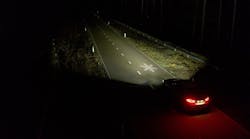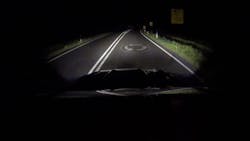According to a study conducted by Britain’s Royal Society for the Prevention of Accidents, 40% of collisions occur in the hours of darkness, when vision is reduced and it becomes more difficult to see road users such as pedestrians, cyclists, and motorcyclists.
This risk is increased whenever a driver takes their eyes off the road. A vehicle traveling at 90 km/hour covers 25 meters per second, meaning even a short glance at the navigation on the in-car screen can result in “driving blind” for 10 meters or more. On an unlit road, this could mean missing an important sign or a bend in the road.
The problem is particularly severe for older road users. Between the ages of 15 and 65, the time it takes to recover from glare increases from 1 to 9 seconds. This is one of the reasons why people find driving at night more difficult, even for experienced drivers. It also takes time for the eyes to adjust to the darkness after being in a lit building or after driving on a well-lit road.
Hi-Res Headlights
Ford Europe is working on what it calls "high-resolution" headlights that do more than just illuminate the road. The headlights also are capable of projecting signs and other information such as directions, speed limits, and weather information directly in the driver's line of sight. Therefore, the driver’s gaze can remain fixed on the way ahead.
The headlights are linked to the infotainment's navigation system. Connecting the headlight to the navigation system enables the system to display upcoming turns on the road.
This technology is based on existing head-up displays (HUDs) that project helpful information on the windshield in front of the driver. In 1988, the Oldsmobile Cutlass Supreme became the first production car with a HUD. Ford goes a step further by using the headlights to project information onto the road in front of the vehicle using augmented-reality (AR) technology
In a Ford Europe demonstration video, these AR-enabled headlights are used to keep the driver up-to-date on changing weather conditions, such as snow falling, fog, slippery conditions, or an icy road ahead by displaying images on the road (e,g., a snowflake).
Said Lars Junker, features and software, Advanced Driver Assistance Systems, Ford Europe, “What started as playing around with a projector light and a blank wall could take lighting technologies to a whole new level. There’s the potential now to do so much more than simply illuminate the road ahead, to help reduce the stress involved in driving at night. The driver could get essential information without ever needing to take their eyes off the road.”
One potentially big complication is that projecting images onto the road may be subject to different legal regulations in different markets. As such, Ford points out that this vehicle feature is being developed for trial purposes only and undergoing testing in controlled environments.
Mercedes’ Digital Light
Ford won't be the first to market with this sort of technology. Mercedes-Benz already offers similar tech on its Mercedes-Maybach S-Class vehicles. Called Digital Light, it allows new functions (e.g. the projection of guidelines or warning symbols) onto the road ahead.
Digital Light has a light module with three LEDs in each headlamp, whose light is refracted and directed by 1.3 million micromirrors. The micromirrors occupy about the same area as a thumbnail. A control unit with a graphic processor uses an HDMI-like connection to generate a continuous video stream to the mirrors. In this sense, Digital Light uses the technology of video projectors.
The beam, divided into 1.3 million pixels, makes precise light distribution possible. According to Mercedes, it makes Highbeam Assist over 100X more precise than an 84-pixel light when excluding oncoming traffic or road signs from the light beam. Light/shadow graduations and the light distribution of all other adaptive light functions also are realized with more precision, optimizing illumination by fog light, motorway light, or city driving light.
Digital Light assists the driver via the following functions:
- Warning of recognized roadworks by projecting an excavator symbol onto the road surface.
- Aiming a spotlight at pedestrians detected at the roadside.
- Traffic lights, stop signs, or no-entry signs are pointed out by projecting a warning symbol onto the road surface.
- Assistance on narrow road lanes (roadworks) by projecting guidelines onto the road surface.

